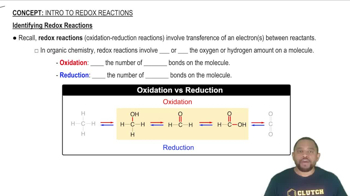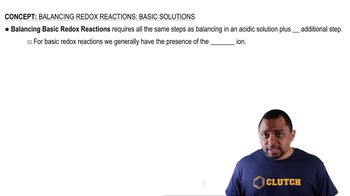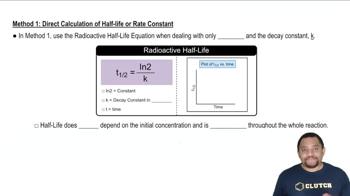Balance each redox reaction occurring in acidic aqueous solution. c. NO3–(aq) + Sn2+(aq) → Sn4+(aq) + NO(g)
Ch.20 - Electrochemistry
Chapter 20, Problem 42a
Balance each redox reaction occurring in basic aqueous solution. a. MnO4–(aq) + Br–(aq) → MnO2(s) + BrO3–(aq)
 Verified step by step guidance
Verified step by step guidance1
Identify the oxidation states of the elements in the reactants and products. For MnO4-, Mn is +7; in MnO2, Mn is +4. For Br-, Br is -1; in BrO3-, Br is +5.
Write the half-reactions for the oxidation and reduction processes. Oxidation: Br- → BrO3-; Reduction: MnO4- → MnO2.
Balance the atoms other than O and H in each half-reaction. For Br: Br- → BrO3-; For Mn: MnO4- → MnO2.
Balance the oxygen atoms by adding water molecules. For the reduction half-reaction: MnO4- → MnO2 + 2H2O.
Balance the hydrogen atoms by adding hydroxide ions (OH-) to both sides of each half-reaction. For the reduction half-reaction: MnO4- + 4H+ + 2e- → MnO2 + 2H2O (add 4OH- to both sides to convert H+ to water).

Verified video answer for a similar problem:
This video solution was recommended by our tutors as helpful for the problem above.
Video duration:
13mWas this helpful?
Key Concepts
Here are the essential concepts you must grasp in order to answer the question correctly.
Redox Reactions
Redox reactions, or reduction-oxidation reactions, involve the transfer of electrons between two species. In these reactions, one species is oxidized (loses electrons) while the other is reduced (gains electrons). Understanding the oxidation states of the elements involved is crucial for identifying which species undergo oxidation and reduction.
Recommended video:
Guided course

Identifying Redox Reactions
Balancing Redox Reactions in Basic Solution
When balancing redox reactions in basic solutions, it is essential to first balance the half-reactions in acidic conditions and then convert them to basic conditions. This is done by adding hydroxide ions (OH-) to both sides of the equation to neutralize any hydrogen ions (H+) present, ensuring that the overall charge and mass are balanced.
Recommended video:
Guided course

Balancing Basic Redox Reactions
Half-Reaction Method
The half-reaction method involves separating the oxidation and reduction processes into two distinct half-reactions. Each half-reaction is balanced for mass and charge, and then the two are combined to form the balanced overall reaction. This method is particularly useful in complex redox reactions, as it simplifies the balancing process.
Recommended video:
Guided course

Method 1 of Radioactive Half-Life
Related Practice
Textbook Question
Textbook Question
Balance each redox reaction occurring in basic aqueous solution. a. H2O2(aq) + ClO2(aq) → ClO2–(aq) + O2(g)
Textbook Question
Balance each redox reaction occurring in basic aqueous solution. b. Al(s) + MnO4–(aq) → MnO2(s) + Al(OH)4–(aq)
Textbook Question
Balance each redox reaction occurring in basic aqueous solution. b. Ag(s) + CN–(aq) + O2(g) → Ag(CN)2–(aq)
Textbook Question
Balance each redox reaction occurring in basic aqueous solution. c. NO2–(aq) + Al(s) → NH3(g) + AlO2–(aq)
Textbook Question
Sketch a voltaic cell for each redox reaction. Label the anode and cathode and indicate the half-reaction that occurs at each electrode and the species present in each solution. Also indicate the direction of electron flow. a. Ni2+(aq) + Mg(s) → Ni(s) + Mg2+(aq)
